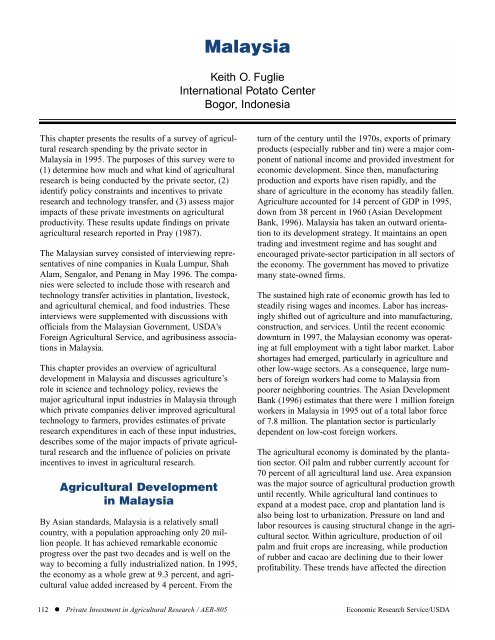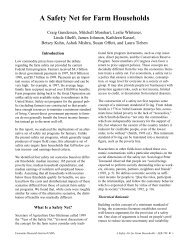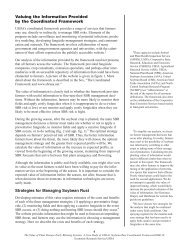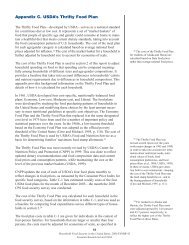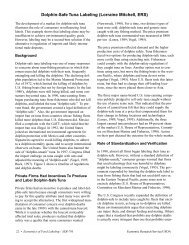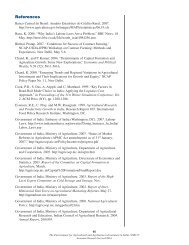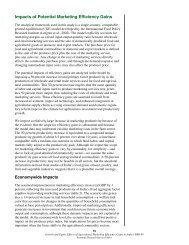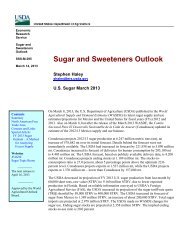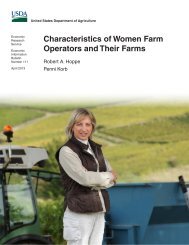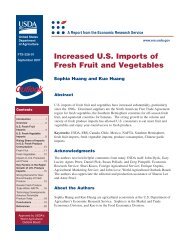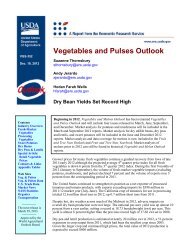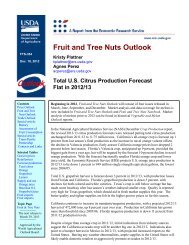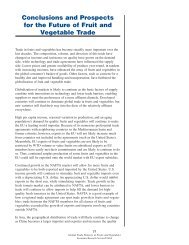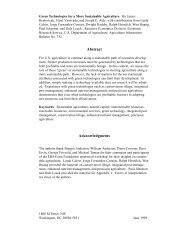Private Investment in Agricultural Research and International..
Private Investment in Agricultural Research and International..
Private Investment in Agricultural Research and International..
You also want an ePaper? Increase the reach of your titles
YUMPU automatically turns print PDFs into web optimized ePapers that Google loves.
This chapter presents the results of a survey of agricultural<br />
research spend<strong>in</strong>g by the private sector <strong>in</strong><br />
Malaysia <strong>in</strong> 1995. The purposes of this survey were to<br />
(1) determ<strong>in</strong>e how much <strong>and</strong> what k<strong>in</strong>d of agricultural<br />
research is be<strong>in</strong>g conducted by the private sector, (2)<br />
identify policy constra<strong>in</strong>ts <strong>and</strong> <strong>in</strong>centives to private<br />
research <strong>and</strong> technology transfer, <strong>and</strong> (3) assess major<br />
impacts of these private <strong>in</strong>vestments on agricultural<br />
productivity. These results update f<strong>in</strong>d<strong>in</strong>gs on private<br />
agricultural research reported <strong>in</strong> Pray (1987).<br />
The Malaysian survey consisted of <strong>in</strong>terview<strong>in</strong>g representatives<br />
of n<strong>in</strong>e companies <strong>in</strong> Kuala Lumpur, Shah<br />
Alam, Sengalor, <strong>and</strong> Penang <strong>in</strong> May 1996. The companies<br />
were selected to <strong>in</strong>clude those with research <strong>and</strong><br />
technology transfer activities <strong>in</strong> plantation, livestock,<br />
<strong>and</strong> agricultural chemical, <strong>and</strong> food <strong>in</strong>dustries. These<br />
<strong>in</strong>terviews were supplemented with discussions with<br />
officials from the Malaysian Government, USDA's<br />
Foreign <strong>Agricultural</strong> Service, <strong>and</strong> agribus<strong>in</strong>ess associations<br />
<strong>in</strong> Malaysia.<br />
This chapter provides an overview of agricultural<br />
development <strong>in</strong> Malaysia <strong>and</strong> discusses agriculture’s<br />
role <strong>in</strong> science <strong>and</strong> technology policy, reviews the<br />
major agricultural <strong>in</strong>put <strong>in</strong>dustries <strong>in</strong> Malaysia through<br />
which private companies deliver improved agricultural<br />
technology to farmers, provides estimates of private<br />
research expenditures <strong>in</strong> each of these <strong>in</strong>put <strong>in</strong>dustries,<br />
describes some of the major impacts of private agricultural<br />
research <strong>and</strong> the <strong>in</strong>fluence of policies on private<br />
<strong>in</strong>centives to <strong>in</strong>vest <strong>in</strong> agricultural research.<br />
<strong>Agricultural</strong> Development<br />
<strong>in</strong> Malaysia<br />
By Asian st<strong>and</strong>ards, Malaysia is a relatively small<br />
country, with a population approach<strong>in</strong>g only 20 million<br />
people. It has achieved remarkable economic<br />
progress over the past two decades <strong>and</strong> is well on the<br />
way to becom<strong>in</strong>g a fully <strong>in</strong>dustrialized nation. In 1995,<br />
the economy as a whole grew at 9.3 percent, <strong>and</strong> agricultural<br />
value added <strong>in</strong>creased by 4 percent. From the<br />
Malaysia<br />
Keith O. Fuglie<br />
<strong>International</strong> Potato Center<br />
Bogor, Indonesia<br />
turn of the century until the 1970s, exports of primary<br />
products (especially rubber <strong>and</strong> t<strong>in</strong>) were a major component<br />
of national <strong>in</strong>come <strong>and</strong> provided <strong>in</strong>vestment for<br />
economic development. S<strong>in</strong>ce then, manufactur<strong>in</strong>g<br />
production <strong>and</strong> exports have risen rapidly, <strong>and</strong> the<br />
share of agriculture <strong>in</strong> the economy has steadily fallen.<br />
Agriculture accounted for 14 percent of GDP <strong>in</strong> 1995,<br />
down from 38 percent <strong>in</strong> 1960 (Asian Development<br />
Bank, 1996). Malaysia has taken an outward orientation<br />
to its development strategy. It ma<strong>in</strong>ta<strong>in</strong>s an open<br />
trad<strong>in</strong>g <strong>and</strong> <strong>in</strong>vestment regime <strong>and</strong> has sought <strong>and</strong><br />
encouraged private-sector participation <strong>in</strong> all sectors of<br />
the economy. The government has moved to privatize<br />
many state-owned firms.<br />
The susta<strong>in</strong>ed high rate of economic growth has led to<br />
steadily ris<strong>in</strong>g wages <strong>and</strong> <strong>in</strong>comes. Labor has <strong>in</strong>creas<strong>in</strong>gly<br />
shifted out of agriculture <strong>and</strong> <strong>in</strong>to manufactur<strong>in</strong>g,<br />
construction, <strong>and</strong> services. Until the recent economic<br />
downturn <strong>in</strong> 1997, the Malaysian economy was operat<strong>in</strong>g<br />
at full employment with a tight labor market. Labor<br />
shortages had emerged, particularly <strong>in</strong> agriculture <strong>and</strong><br />
other low-wage sectors. As a consequence, large numbers<br />
of foreign workers had come to Malaysia from<br />
poorer neighbor<strong>in</strong>g countries. The Asian Development<br />
Bank (1996) estimates that there were 1 million foreign<br />
workers <strong>in</strong> Malaysia <strong>in</strong> 1995 out of a total labor force<br />
of 7.8 million. The plantation sector is particularly<br />
dependent on low-cost foreign workers.<br />
The agricultural economy is dom<strong>in</strong>ated by the plantation<br />
sector. Oil palm <strong>and</strong> rubber currently account for<br />
70 percent of all agricultural l<strong>and</strong> use. Area expansion<br />
was the major source of agricultural production growth<br />
until recently. While agricultural l<strong>and</strong> cont<strong>in</strong>ues to<br />
exp<strong>and</strong> at a modest pace, crop <strong>and</strong> plantation l<strong>and</strong> is<br />
also be<strong>in</strong>g lost to urbanization. Pressure on l<strong>and</strong> <strong>and</strong><br />
labor resources is caus<strong>in</strong>g structural change <strong>in</strong> the agricultural<br />
sector. With<strong>in</strong> agriculture, production of oil<br />
palm <strong>and</strong> fruit crops are <strong>in</strong>creas<strong>in</strong>g, while production<br />
of rubber <strong>and</strong> cacao are decl<strong>in</strong><strong>in</strong>g due to their lower<br />
profitability. These trends have affected the direction<br />
112 l <strong>Private</strong> <strong>Investment</strong> <strong>in</strong> <strong>Agricultural</strong> <strong>Research</strong> / AER-805 Economic <strong>Research</strong> Service/USDA
of agricultural research <strong>in</strong>vestments by the private sector<br />
<strong>in</strong> Malaysia, as described below.<br />
Malaysia has emphasized the production of plantation<br />
crops where it ma<strong>in</strong>ta<strong>in</strong>s a comparative advantage. As<br />
a consequence, it relies on imports for a large part of<br />
its food <strong>and</strong> feed needs. It currently imports about 35<br />
percent of its rice needs, most of its corn <strong>and</strong> soybeans,<br />
<strong>and</strong> all of its wheat. It also is a net importer of<br />
horticultural crops. For many of the imported agricultural<br />
commodities, Malaysia adds value locally<br />
through livestock production <strong>and</strong> food process<strong>in</strong>g.<br />
However, retail prices for the most important foods<br />
(rice, wheat flour, poultry) are adm<strong>in</strong>istratively determ<strong>in</strong>ed,<br />
<strong>and</strong> shortages may emerge if world prices rise<br />
above domestic prices. Nevertheless, trends toward<br />
greater reliance on imports for basic food <strong>and</strong> feed<br />
commodities are likely to cont<strong>in</strong>ue (Rahman, 1996). In<br />
its 7th Development Plan (1996-2000), the Malaysian<br />
Government cont<strong>in</strong>ued to pursue agricultural growth<br />
through more efficient resource allocation, emphasiz<strong>in</strong>g<br />
commodities <strong>in</strong> which it ma<strong>in</strong>ta<strong>in</strong>s a comparative<br />
advantage, such as plantation crops, <strong>and</strong> de-emphasiz<strong>in</strong>g<br />
self-sufficiency goals <strong>in</strong> food <strong>and</strong> feed crops.<br />
Structure of <strong>Agricultural</strong><br />
Input Industries<br />
A pr<strong>in</strong>cipal way for new technology to reach farmers<br />
is to supply them with new <strong>and</strong> improved agricultural<br />
<strong>in</strong>puts, such as better seed, livestock feed, crop protection<br />
chemicals, livestock pharmaceuticals, <strong>and</strong> farm<br />
mach<strong>in</strong>ery. The private sector can be expected to <strong>in</strong>vest<br />
<strong>in</strong> research to improve agricultural <strong>in</strong>puts when (1) the<br />
size of the market is sufficiently large, (2) technological<br />
improvements can be made relatively quickly <strong>and</strong><br />
easily, <strong>and</strong> (3) <strong>in</strong>dividual companies have some means<br />
of protect<strong>in</strong>g their <strong>in</strong>tellectual property from copiers<br />
(Pray <strong>and</strong> Fuglie, 1996). Before exam<strong>in</strong><strong>in</strong>g private-sector<br />
<strong>in</strong>vestment <strong>in</strong> agricultural research, a brief review<br />
of agricultural <strong>in</strong>put sectors is provided.<br />
Plantations (Perennials)<br />
Plantation or perennial crops play an important role <strong>in</strong><br />
the Malaysian economy <strong>and</strong> a dom<strong>in</strong>ant role <strong>in</strong> its<br />
agricultural sector. They occupy 70 percent of the agricultural<br />
l<strong>and</strong> <strong>and</strong> account for a similar proportion of<br />
agricultural value added. The most important perennial<br />
is oil palm, followed by rubber <strong>and</strong> cacao.<br />
The orig<strong>in</strong> of the Malaysian plantation economy dates<br />
back to the latter part of the 19th century, when colonial<br />
planters <strong>in</strong>troduced rubber trees from South America<br />
<strong>and</strong> oil palm trees from West Africa. The growth of<br />
the automobile <strong>and</strong> electrical <strong>in</strong>dustries <strong>in</strong> western<br />
countries sparked an <strong>in</strong>ternational rubber boom.<br />
Malaysia became the primary source of natural rubber<br />
for automobile tires, electrical wires, <strong>and</strong> other uses.<br />
To support the <strong>in</strong>dustry, the Rubber <strong>Research</strong> Institute<br />
of Malaysia (RRIM) was established <strong>in</strong> 1910 to<br />
develop improved technology for the <strong>in</strong>dustry (Pray,<br />
1991). While rubber has lost its number one position<br />
<strong>in</strong> the agricultural sector to oil palm, it cont<strong>in</strong>ued to<br />
occupy more than 30 percent of agricultural l<strong>and</strong> <strong>in</strong><br />
1994, or 1.73 million hectares (table F-1).<br />
At the time of Malaysian <strong>in</strong>dependence <strong>in</strong> 1964, most<br />
rubber <strong>and</strong> oil palm plantations were foreign owned.<br />
The Malaysian Government encouraged a process of<br />
“Malaysianization” to transfer ownership to local<br />
<strong>in</strong>terests. Government <strong>in</strong>vestment bodies such as the<br />
National <strong>Investment</strong> Board (PNB) were <strong>in</strong>strumental<br />
<strong>in</strong> buy<strong>in</strong>g out foreign-owned plantations <strong>and</strong> transferr<strong>in</strong>g<br />
stock hold<strong>in</strong>gs to local ownership. By the early<br />
1990s, the process of Malaysianization was largely<br />
complete. The PNB ma<strong>in</strong>ta<strong>in</strong>s large share hold<strong>in</strong>gs (30<br />
percent or more) <strong>in</strong> three of the largest plantation companies<br />
<strong>in</strong> Malaysia (Guthrie, Sime Darby, <strong>and</strong> Golden<br />
Hope, formerly Harrison-Crossfield).<br />
While rubber production was started by large plantations,<br />
it spread to small holders. By 1960, 60 percent<br />
of rubber area was held by small holders. By 1994,<br />
small holders’ share of rubber area had further<br />
<strong>in</strong>creased to 80 percent. The pr<strong>in</strong>cipal reason for the<br />
decl<strong>in</strong>e <strong>in</strong> the share of rubber area held by estates is<br />
the ris<strong>in</strong>g cost of labor. Rubber tapp<strong>in</strong>g rema<strong>in</strong>s a<br />
labor-<strong>in</strong>tensive activity despite efforts to mechanize<br />
production. In a recent study of efficiency <strong>in</strong> the<br />
Malaysian rubber economy, Chew <strong>and</strong> Mohayid<strong>in</strong><br />
found no evidence of economies of scale <strong>in</strong> rubber<br />
production. While some economies of scale probably<br />
exist <strong>in</strong> plantation establishment (l<strong>and</strong> clear<strong>in</strong>g <strong>and</strong><br />
plant<strong>in</strong>g), there are no such economies at the labor<strong>in</strong>tensive<br />
tapp<strong>in</strong>g (harvest<strong>in</strong>g) stage. Small holders<br />
may actually have a cost advantage <strong>in</strong> operat<strong>in</strong>g established<br />
plantations because the cost of monitor<strong>in</strong>g hired<br />
labor is reduced.<br />
Another major structural change <strong>in</strong> the Malaysia rubber<br />
sector is the development of a local process<strong>in</strong>g<br />
<strong>in</strong>dustry to transform raw rubber (latex) <strong>in</strong>to value-<br />
Economic <strong>Research</strong> Service/USDA <strong>Private</strong> <strong>Investment</strong> <strong>in</strong> <strong>Agricultural</strong> <strong>Research</strong> / AER-805 l 113
Table F-1—<strong>Agricultural</strong> cropl<strong>and</strong> <strong>in</strong> Malaysia (area harvested)<br />
1990 Share of total cropl<strong>and</strong> 1995 Share of total cropl<strong>and</strong><br />
1,000 hectares Percent 1,000 hectares Percent<br />
Industrial crops:<br />
Oil palm 1,746 35.5 2,235 43.5<br />
Rubber 1,614 32.8 1,475 28.7<br />
Coconut 316 6.4 265 5.2<br />
Cacao 298 6.1 210 4.1<br />
Sugarcane 22 0.4 24 0.5<br />
Coffee<br />
Food <strong>and</strong> other crops:<br />
13 0.1 15 0.3<br />
Rice 681 13.8 673 13.1<br />
Fruits 99 2.0 103 2.0<br />
Vegetables 18 0.4 23 0.5<br />
Cassava 39 0.8 42 0.8<br />
Corn 20 0.4 23 0.4<br />
Peppers 12 0.2 10 0.2<br />
Tobacco 11 0.2 10 0.2<br />
Total cropl<strong>and</strong> 4,917 100.0 5,139 100.0<br />
Source: FAOSTAT.<br />
added products for domestic consumption <strong>and</strong> export.<br />
The share of rubber production exported as latex is<br />
shr<strong>in</strong>k<strong>in</strong>g, while exports of rubber products such as<br />
automobile tires <strong>and</strong> latex gloves is <strong>in</strong>creas<strong>in</strong>g. A similar<br />
trend can be seen <strong>in</strong> the palm oil <strong>in</strong>dustry.<br />
Though oil palm was <strong>in</strong>troduced <strong>in</strong>to Malaysia <strong>in</strong> the<br />
late 1800s, it rema<strong>in</strong>ed a relatively m<strong>in</strong>or crop until the<br />
1960s. S<strong>in</strong>ce then, production has exp<strong>and</strong>ed rapidly.<br />
Oil palm surpassed rubber as the pr<strong>in</strong>cipal agricultural<br />
commodity of Malaysia <strong>in</strong> the 1970s, <strong>and</strong> its share of<br />
total agricultural production is projected to cont<strong>in</strong>ue to<br />
<strong>in</strong>crease. Between 1960 <strong>and</strong> 1993, the production of<br />
crude palm oil (CPO) <strong>in</strong>creased from 90,000 metric<br />
tons to 7.4 million tons per year. Currently, 2.4 million<br />
hectares are planted with oil palm, cover<strong>in</strong>g 42 percent<br />
of all agricultural l<strong>and</strong> <strong>in</strong> Malaysia.<br />
Unlike rubber, oil palm production rema<strong>in</strong>s largely an<br />
estate crop. Due to the high level of organization <strong>and</strong><br />
large capital <strong>in</strong>vestment <strong>in</strong>volved, there are significant<br />
economies of scale <strong>in</strong> oil palm production. Only about<br />
10 percent of the oil palm area is operated by small<br />
holders, <strong>and</strong> the rest by large estates. Half of the oil<br />
palm area is <strong>in</strong> the h<strong>and</strong>s of large private plantations,<br />
<strong>and</strong> the rema<strong>in</strong><strong>in</strong>g 40 percent by state-owned plantations,<br />
the largest operated by the Federal L<strong>and</strong> Development<br />
Authority (FELDA).<br />
As with rubber, Malaysia is gradually exp<strong>and</strong><strong>in</strong>g its<br />
downstream process<strong>in</strong>g capacity for palm oil products.<br />
Most palm oil is processed <strong>in</strong>to food products such as<br />
cook<strong>in</strong>g oil, but an <strong>in</strong>creas<strong>in</strong>g share is be<strong>in</strong>g used for<br />
nonfood products, such as soaps, detergents, <strong>and</strong> oleochemicals.<br />
In 1995, about 20 percent of Malaysian<br />
palm oil production went for nonfood uses, up from 10<br />
percent <strong>in</strong> 1979.<br />
Malaysian oil palm <strong>and</strong> rubber companies are exp<strong>and</strong><strong>in</strong>g<br />
their plantation hold<strong>in</strong>gs <strong>in</strong> other countries due to<br />
decl<strong>in</strong><strong>in</strong>g l<strong>and</strong> availability <strong>and</strong> labor shortages at<br />
home. Several Malaysian-owned corporations have<br />
<strong>in</strong>vested <strong>in</strong> new plantations <strong>in</strong> Indonesia <strong>and</strong> Vietnam.<br />
So far, these <strong>in</strong>vestments have been primarily for raw<br />
material production of latex <strong>and</strong> crude oil palm. Further<br />
downstream ref<strong>in</strong><strong>in</strong>g takes place <strong>in</strong> Malaysia.<br />
Cacao is a third estate crop that grew steadily <strong>in</strong> the<br />
1980s but decl<strong>in</strong>ed <strong>in</strong> Malaysia <strong>in</strong> the 1990s due to a<br />
sharp drop <strong>in</strong> world cocoa prices. Economic forecasts<br />
of world cocoa dem<strong>and</strong> suggest that low prices will<br />
likely cont<strong>in</strong>ue <strong>in</strong>to the future, ma<strong>in</strong>ly due to the<br />
development of cocoa substitutes such as vegetable<br />
oils for cocoa butter <strong>in</strong> chocolates. Plantations that<br />
<strong>in</strong>vested <strong>in</strong> cacao production are replant<strong>in</strong>g these areas<br />
to oil palm, leav<strong>in</strong>g cacao production primarily to<br />
small holders.<br />
Other areas where the estate sector is active are <strong>in</strong><br />
tropical fruit production, tropical hardwoods, <strong>and</strong><br />
sugar cane. These are relatively small activities at present.<br />
Many of the oil palm <strong>and</strong> rubber plantation companies<br />
are diversify<strong>in</strong>g <strong>in</strong>to manufactur<strong>in</strong>g <strong>and</strong> real<br />
estate development.<br />
114 l <strong>Private</strong> <strong>Investment</strong> <strong>in</strong> <strong>Agricultural</strong> <strong>Research</strong> / AER-805 Economic <strong>Research</strong> Service/USDA
Animal Sector<br />
Poultry is the largest component of the animal sector<br />
<strong>in</strong> Malaysia. The Malaysian poultry <strong>in</strong>dustry supplies<br />
domestic dem<strong>and</strong> for poultry products <strong>and</strong> also exports<br />
some products, ma<strong>in</strong>ly to S<strong>in</strong>gapore. Per capita consumption<br />
of chicken <strong>and</strong> chicken eggs <strong>in</strong> Malaysia is<br />
among the highest <strong>in</strong> the world (table F-2). Poultry<br />
products are the pr<strong>in</strong>cipal source of meat prote<strong>in</strong><br />
because local cultural <strong>and</strong> religious norms place no<br />
dietary prohibitions on chicken consumption, while<br />
some religious or ethnic groups will not consume beef<br />
<strong>and</strong> pork.<br />
Dur<strong>in</strong>g the past three decades, the Malaysian poultry<br />
<strong>in</strong>dustry has evolved from small back-yard operations<br />
<strong>in</strong>to relatively modern, large-scale commercial operations.<br />
One of the factors contribut<strong>in</strong>g to the growth of<br />
the poultry sector is the replacement of local breeds<br />
with high-quality poultry breeds from the United<br />
States, Europe, Canada, <strong>and</strong> Australia. A second factor<br />
is the growth of highly efficient <strong>in</strong>tegrated production<br />
systems. Six of the largest broiler operations are now<br />
fully <strong>in</strong>tegrated with breeder farms, feedmills, process<strong>in</strong>g<br />
plants, <strong>and</strong> <strong>in</strong> some cases, retail outlets (table F-3).<br />
The <strong>in</strong>tegrated firms account for two-thirds of broiler<br />
production <strong>in</strong> Malaysia <strong>and</strong> are steadily <strong>in</strong>creas<strong>in</strong>g<br />
their market share. There are about 5,000 smaller<br />
broiler operations, nearly all of which also use modern<br />
breed<strong>in</strong>g stock <strong>and</strong> production methods. Chicken egg<br />
production has also moved rapidly toward large-scale<br />
production, but has not seen the same degree of <strong>in</strong>tegration<br />
as <strong>in</strong> the broiler <strong>in</strong>dustry.<br />
In 1994, there were two gr<strong>and</strong>parent broiler breeder<br />
farms <strong>in</strong> Malaysia that produced 65 percent of day-old<br />
parent stock, the rest be<strong>in</strong>g imported. A third gr<strong>and</strong>-<br />
Table F-3—Integrated poultry firms <strong>in</strong> Malaysia<br />
Company Gr<strong>and</strong>parent stock farm<br />
Charoen Pokph<strong>and</strong> Jaya Farm yes<br />
Leong Hup Poultry Farms yes<br />
D<strong>in</strong>d<strong>in</strong>gs Broiler Breeder Farm<br />
Goldkist Breed<strong>in</strong>g Farm<br />
KFC Breeder Farm & Hatchery<br />
S<strong>in</strong>mah Multifeed<br />
Source: <strong>Agricultural</strong> Counselor, U.S. Embassy, Kuala Lumpur,<br />
Malaysia.<br />
parent farm is expected to beg<strong>in</strong> operation <strong>in</strong> the near<br />
future. There are also 82 parent broiler stock farms.<br />
For layers, all gr<strong>and</strong>parent stock is imported. There are<br />
14 parent layer stock farms <strong>in</strong> the country. There are<br />
no pure-l<strong>in</strong>e stock farms for either broilers or layers.<br />
After poultry, sw<strong>in</strong>e is the next largest component of<br />
the Malaysian animal <strong>in</strong>dustry. Pork is consumed by<br />
non-Muslim Malaysians who make up a significant<br />
m<strong>in</strong>ority of the population. While pork production<br />
tripled between 1970 <strong>and</strong> 1993, future growth <strong>in</strong> sw<strong>in</strong>e<br />
production may be constra<strong>in</strong>ed due to environmental<br />
<strong>and</strong> religious concerns. Regulations limit the areas <strong>in</strong><br />
which sw<strong>in</strong>e can be produced <strong>and</strong> how waste products<br />
are h<strong>and</strong>led.<br />
As with poultry, Malaysian pig farmers have adopted<br />
modern breeds <strong>and</strong> production methods. Genetic<br />
improvement has played an important role <strong>in</strong> the<br />
development of the Malaysian sw<strong>in</strong>e <strong>in</strong>dustry. Breed<strong>in</strong>g<br />
stock are imported primarily from Taiwan, Europe,<br />
North America, <strong>and</strong> Australia. There is currently only<br />
one pig breed<strong>in</strong>g farm <strong>in</strong> Malaysia (a jo<strong>in</strong>t-venture<br />
with a Taiwanese company). In 1994, there were about<br />
4,000 pig producers <strong>in</strong> Malaysia. Twenty percent (800<br />
farms) had over 1,000 head <strong>and</strong> accounted for 70 per-<br />
Table F-2—Animal production <strong>in</strong> Malaysia, 1995<br />
Type Population Production Consumption per capita<br />
1,000 head 1,000 metric tons kg<br />
Poultry—broilers 377,000 661 32.91<br />
Poultry—layers 20,000 5.9 billion1 3311 Sw<strong>in</strong>e 3,282 230 32.35<br />
Beef (cattle & buffalo)<br />
Mutton (goat, sheep<br />
846 18 4.38<br />
& lamb) 570 1 0.97<br />
Milk (cow & buffalo) 43 46.2<br />
1Egg production <strong>and</strong> consumption <strong>in</strong> number of pieces.<br />
Source: Production <strong>and</strong> number of live animals except poultry from FAOSTAT; Number of poultry broilers <strong>and</strong> layers <strong>and</strong> consumption<br />
per capita from <strong>Agricultural</strong> Counselor, U.S. Embassy, Kuala Lumpur, Malaysia.<br />
Economic <strong>Research</strong> Service/USDA <strong>Private</strong> <strong>Investment</strong> <strong>in</strong> <strong>Agricultural</strong> <strong>Research</strong> / AER-805 l 115
cent of total pork production. Small operations are<br />
steadily be<strong>in</strong>g replaced by large <strong>in</strong>tensive operations.<br />
Animal diseases rema<strong>in</strong> a major problem <strong>and</strong> are exacerbated<br />
by <strong>in</strong>creased rear<strong>in</strong>g density of herds.<br />
Cattle <strong>and</strong> rum<strong>in</strong>ants are relatively unimportant <strong>in</strong> the<br />
Malaysian livestock <strong>in</strong>dustry, ma<strong>in</strong>ly because of the<br />
lack of pasture l<strong>and</strong>. There have been some attempts to<br />
<strong>in</strong>tegrate livestock production with plantations us<strong>in</strong>g<br />
the undergrowth as pasture for cattle or sheep. But so<br />
far, these schemes have not been successful.<br />
<strong>Agricultural</strong> Chemicals<br />
The use of agricultural chemicals <strong>in</strong> Malaysia is dom<strong>in</strong>ated<br />
by the plantation sector, which accounts for<br />
three-fourths of all sales. Herbicides are widely used<br />
<strong>in</strong> plantations to reduce undergrowth so that the trees<br />
face less competition for soil nutrients <strong>and</strong> are easier<br />
to reach for prun<strong>in</strong>g <strong>and</strong> harvest<strong>in</strong>g. Herbicides<br />
account for about 75 percent of the total value of pesticide<br />
sales <strong>in</strong> Malaysia, <strong>and</strong> more than 90 percent of<br />
the pesticides used <strong>in</strong> plantations. Insecticides account<br />
for 15 percent of total sales, <strong>and</strong> are used primarily <strong>in</strong><br />
vegetable <strong>and</strong> rice production. Fungicides are primarily<br />
applied to horticultural crops. Rodenticides are<br />
applied <strong>in</strong> oil palm plantations to protect fruit from<br />
damage by rats.<br />
Farm Mach<strong>in</strong>ery<br />
Increas<strong>in</strong>g labor costs <strong>in</strong> the rapidly develop<strong>in</strong>g<br />
Malaysian economy have <strong>in</strong>creased the dem<strong>and</strong> for<br />
agricultural mach<strong>in</strong>ery (table F-4). Rice production is<br />
now mostly mechanized, with tractor till<strong>in</strong>g, mechanized<br />
seed<strong>in</strong>g, <strong>and</strong> comb<strong>in</strong>e harvest<strong>in</strong>g. Efforts have<br />
also <strong>in</strong>creased to mechanize operations <strong>in</strong> the plantation<br />
sector, but progress has been slow. Rubber-tree<br />
tapp<strong>in</strong>g <strong>and</strong> oil palm harvest<strong>in</strong>g rema<strong>in</strong> manual activities.<br />
Transport<strong>in</strong>g raw materials from the field to the<br />
mills has been mechanized.<br />
Table F-4—Malaysian imports of agricultural<br />
mach<strong>in</strong>ery<br />
1985<br />
US$1,000<br />
1991<br />
Tractors 25,494 49,177<br />
Irrigation pumps 18,649 104,491<br />
Chemical sprayers 3,198 23,093<br />
Poultry <strong>in</strong>cubators 1,665 12,516<br />
Power tillers 2,638 12,419<br />
Comb<strong>in</strong>e harvesters<br />
Source: Nasarud<strong>in</strong>, 1995.<br />
3,083 4,278<br />
Several foreign agricultural mach<strong>in</strong>ery firms from<br />
Europe, Japan, <strong>and</strong> North America have affiliates or<br />
partner companies <strong>in</strong> Malaysia. Tractors Malaysia, for<br />
example, a part of the Sime Darby group of companies,<br />
has a Ford agricultural mach<strong>in</strong>ery franchise for<br />
Malaysia. Most agricultural mach<strong>in</strong>ery companies <strong>in</strong><br />
Malaysia import foreign mach<strong>in</strong>ery or parts for assembly<br />
<strong>and</strong> distribution locally. Only one local firm<br />
designs <strong>and</strong> manufactures farm implements directly<br />
(Nasarud<strong>in</strong>, 1995). Recently, there have been some<br />
attempts to modify imported designs to suit particular<br />
local needs or requirements. For example, Tractors<br />
Malaysia modified some imported mach<strong>in</strong>ery to make<br />
them more suitable for <strong>in</strong>-field transport of oil palm<br />
fruit bunches.<br />
<strong>Private</strong>-Sector <strong>Investment</strong><br />
<strong>in</strong> <strong>Agricultural</strong> <strong>Research</strong><br />
Plantations<br />
Dur<strong>in</strong>g the past 10 years, private-sector <strong>in</strong>vestment <strong>in</strong><br />
research for plantation crops shifted almost entirely <strong>in</strong>to<br />
oil palm, while private research on rubber <strong>and</strong> cacao<br />
was reduced. This trend was driven by expected future<br />
market potential for these crops. As discussed above,<br />
high labor costs <strong>in</strong> rubber production <strong>and</strong> low prices for<br />
cocoa reduced the prospects for these crops <strong>in</strong> Malaysia<br />
while the outlook for oil palm rema<strong>in</strong>s optimistic.<br />
<strong>Private</strong> research on oil palm is closely l<strong>in</strong>ked to public<br />
research at the Palm Oil <strong>Research</strong> Institute of Malaysia<br />
(PORIM). PORIM is the world's premier research<br />
<strong>in</strong>stitute on oil palm production <strong>and</strong> utilization. For oil<br />
palm production, private plantations rely on PORIM<br />
for basic <strong>and</strong> pre-technology research. Plantations<br />
focus on applied problems, especially breed<strong>in</strong>g, soil<br />
<strong>and</strong> fertility management, waste management, pest <strong>and</strong><br />
disease control, <strong>and</strong> mechanization. PORIM collects,<br />
ma<strong>in</strong>ta<strong>in</strong>s, <strong>and</strong> evaluates oil palm germplasm from<br />
around the world. <strong>Private</strong> breed<strong>in</strong>g programs can<br />
access this germplasm for promis<strong>in</strong>g new traits. For<br />
post-harvest process<strong>in</strong>g <strong>and</strong> product development,<br />
PORIM plays a lead<strong>in</strong>g role <strong>in</strong> both pre-technology<br />
<strong>and</strong> applied research. The private sector has been<br />
reluctant to allocate research resources to new product<br />
development until the market prospects for these products<br />
are more certa<strong>in</strong>.<br />
Seven plantations account for most research conducted<br />
outside of PORIM (table F-5). The extent to which this<br />
research is classified as “private-sector research”<br />
116 l <strong>Private</strong> <strong>Investment</strong> <strong>in</strong> <strong>Agricultural</strong> <strong>Research</strong> / AER-805 Economic <strong>Research</strong> Service/USDA
Table F-5—<strong>Private</strong> <strong>and</strong> public plantation research <strong>in</strong> Malaysia, 1995<br />
Company Crop <strong>Research</strong> SY<br />
requires some qualification. The government <strong>in</strong>vests<br />
directly <strong>in</strong> many of these companies through stock<br />
hold<strong>in</strong>gs managed by the National <strong>Investment</strong> Board<br />
(PNB). PNB holds at least 30-percent ownership <strong>in</strong><br />
three of the largest plantation companies (Golden<br />
Hope, Guthrie, <strong>and</strong> Sime Darby). Two more plantations<br />
are state-owned or state-run (East Plantation<br />
Agency <strong>and</strong> FELDA). The other two plantations with<br />
research programs are United Plantations <strong>and</strong> KL<br />
Kepong. Together, these seven companies are estimated<br />
to have spent about 36.8 million Malaysian<br />
R<strong>in</strong>ggits, or $14.7 million, on R&D <strong>in</strong> 1995. Nearly all<br />
of this was for oil palm research. A small amount went<br />
for rubber, fruit crops, <strong>and</strong> tropical forestry.<br />
Three companies ma<strong>in</strong>ta<strong>in</strong> their own breed<strong>in</strong>g program<br />
<strong>and</strong> produce most of the improved oil palm<br />
seeds (Guthrie, Golden Hope, <strong>and</strong> FELDA). PORIM<br />
itself is restricted by law from sell<strong>in</strong>g seeds to plantations,<br />
although PORIM does provide oil palm seed for<br />
small holders. Due to the cont<strong>in</strong>u<strong>in</strong>g expansion of oil<br />
palm area <strong>and</strong> the need for replant<strong>in</strong>g old trees, there<br />
is a large dem<strong>and</strong> for high-yield<strong>in</strong>g oil palm seeds.<br />
Other plantations are beg<strong>in</strong>n<strong>in</strong>g their own seed production<br />
programs.<br />
<strong>Research</strong> on rubber production is <strong>in</strong>creas<strong>in</strong>gly dom<strong>in</strong>ated<br />
by RRIM, s<strong>in</strong>ce private plantations account for<br />
less than 20 percent of total production <strong>and</strong> their share<br />
1,000 RM/yr<br />
Golden Hope oil palm (70%)<br />
rubber (20%)<br />
cacao, fruit (10%)<br />
10,000 20<br />
Guthrie oil palm 5,000 10<br />
United Plantations oil palm 2,000 4<br />
Sime Darby oil palm 7,300 14<br />
East Plantation Agency oil palm 2,000 4<br />
FELDA 7,500 15<br />
KL Kepong oil palm 2,000 4<br />
Perlis Plantation oil palm<br />
sugarcane<br />
fruits, tobacco<br />
1,000 2<br />
Total private plantation research 36,800 73<br />
Cocoa Board cacao 1,410 5<br />
Palm Oil <strong>Research</strong> Institute of Malaysia oil palm 45,422 130<br />
Rubber <strong>Research</strong> Institute of Malaysia rubber research: 49,000 77<br />
(extension: 21,000 33)<br />
Total public plantation research 95,832 212<br />
Total plantation research<br />
Source: Industry estimates from author's survey.<br />
132,632 285<br />
cont<strong>in</strong>ues to decl<strong>in</strong>e. RRIM allocates about 70 percent<br />
of its scientific <strong>and</strong> technical resources to research <strong>and</strong><br />
about 30 percent to extension. RRIM also conducts<br />
research on rubber post-harvest <strong>and</strong> process<strong>in</strong>g. In<br />
addition, Sime Darby ma<strong>in</strong>ta<strong>in</strong>s its own <strong>in</strong>-house laboratory<br />
<strong>in</strong> tire research. The private sector is represented<br />
<strong>in</strong> RRIM research programs through the Malay Rubber<br />
Producers Council for production research <strong>and</strong> through<br />
the Malay Rubber Product Manufacturers Association<br />
for process<strong>in</strong>g research.<br />
The Malaysian plantation research <strong>in</strong>stitutes also<br />
ma<strong>in</strong>ta<strong>in</strong> formal l<strong>in</strong>kages with research <strong>in</strong>stitutes <strong>in</strong><br />
other countries. Through collaborative research activities,<br />
new sources of technology <strong>and</strong> plant germplasm<br />
are <strong>in</strong>troduced <strong>in</strong>to the Malaysian plantation economy.<br />
RRIM is a member of the <strong>International</strong> Rubber<br />
<strong>Research</strong> <strong>and</strong> Development Board (IRRDB), which<br />
has its secretariat <strong>in</strong> the U.K. IRRDB has sponsored<br />
collections of l<strong>and</strong>races of rubber germplasm. The<br />
world rubber germplasm bank is ma<strong>in</strong>ta<strong>in</strong>ed by RRIM<br />
<strong>in</strong> Malaysia <strong>and</strong> is accessible to all members. RRIM<br />
also supports research <strong>in</strong> other countries. RRIM has<br />
supported research s<strong>in</strong>ce 1938 at a U.K. lab that<br />
focuses on rubber utilization <strong>and</strong> dem<strong>and</strong>. For several<br />
years RRIM also ma<strong>in</strong>ta<strong>in</strong>ed a research lab <strong>in</strong> Brazil<br />
(<strong>in</strong> collaboration with the Brazilian rubber research<br />
system) to study blight diseases; this lab was closed <strong>in</strong><br />
1990.<br />
Economic <strong>Research</strong> Service/USDA <strong>Private</strong> <strong>Investment</strong> <strong>in</strong> <strong>Agricultural</strong> <strong>Research</strong> / AER-805 l 117
<strong>Agricultural</strong> Chemicals<br />
Three agricultural chemical companies ma<strong>in</strong>ta<strong>in</strong><br />
research stations <strong>in</strong> Malaysia with a fourth reportedly<br />
to open possibly by 2002. For two of the companies<br />
(Novartis <strong>and</strong> Zeneca), their Malaysian research facilities<br />
form part of their worldwide test<strong>in</strong>g network for<br />
agricultural chemical development. In addition to test<strong>in</strong>g<br />
new chemical compounds, these research stations<br />
develop crop protection technology for local markets,<br />
primarily <strong>in</strong> the plantation sector. Local R&D also<br />
supports the registration of chemicals for sale <strong>in</strong><br />
Malaysia. <strong>Agricultural</strong> chemicals must be reregistered<br />
every 3 years under the 1974 Pesticide Act.<br />
The mult<strong>in</strong>ational l<strong>in</strong>kages are important for technology<br />
development <strong>and</strong> transfer. For example, Zeneca<br />
holds 25-percent ownership of CCM Bioscience, a<br />
local chemical firm that manufactures agricultural<br />
chemicals <strong>and</strong> fertilizers. CCM Bioscience ma<strong>in</strong>ta<strong>in</strong>s a<br />
23-acre research station <strong>in</strong> Malaysia (it will be moved<br />
to a larger, 43-acre site possibly by 2003). These<br />
research stations form part of Zeneca's global research<br />
system. Zeneca ma<strong>in</strong>ta<strong>in</strong>s research laboratories <strong>in</strong> the<br />
U.K. <strong>and</strong> United States for synthesiz<strong>in</strong>g new chemical<br />
compounds. These compounds are then tested for efficacy<br />
<strong>and</strong> environmental effects at Zeneca's global network<br />
of 12 field research stations. Four of Zeneca's<br />
stations are ma<strong>in</strong>ta<strong>in</strong>ed <strong>in</strong> the Asia-Pacific region<br />
(Malaysia, Philipp<strong>in</strong>es, Thail<strong>and</strong>, <strong>and</strong> Japan). Zeneca's<br />
Malaysian station is designed to test weed <strong>and</strong> rodent<br />
control under tropical conditions.<br />
Similarly, Novartis ma<strong>in</strong>ta<strong>in</strong>s a research facility <strong>in</strong><br />
Malaysia as part of its global test<strong>in</strong>g network for<br />
new chemical compounds developed at its Swiss<br />
laboratories. Novartis conducts field research <strong>in</strong><br />
Thail<strong>and</strong>, Indonesia, <strong>and</strong> Japan <strong>in</strong> Asia, Egypt <strong>and</strong><br />
South Africa <strong>in</strong> Africa, Brazil <strong>in</strong> South America, as<br />
well as <strong>in</strong> the United States <strong>and</strong> Europe. This network<br />
allows Novartis to test new chemical compounds<br />
year-round under different environmental<br />
conditions. The Malaysian facility focuses primarily<br />
on test<strong>in</strong>g herbicides, fungicides, <strong>and</strong> <strong>in</strong>secticides for<br />
use on plantation crops (oil palm <strong>and</strong> cacao), rice,<br />
<strong>and</strong> horticultural crops.<br />
<strong>Private</strong> agricultural chemical research <strong>in</strong> Malaysia was<br />
estimated at about 4.5 million RM <strong>in</strong> 1995 (table F-6),<br />
<strong>and</strong> likely <strong>in</strong>creased <strong>in</strong> 1996 <strong>and</strong> 1997 when AgrEvo<br />
(formerly Hoerchst) opened a new station <strong>and</strong> CCM<br />
Bioscience moved its research to a larger facility.<br />
Farm Mach<strong>in</strong>ery<br />
Increased wages <strong>and</strong> labor scarcity <strong>in</strong> Malaysian agriculture<br />
have <strong>in</strong>creased the dem<strong>and</strong> for agricultural<br />
mach<strong>in</strong>ery. Most mechanization <strong>in</strong>volves the direct<br />
importation of foreign mach<strong>in</strong>es or their designs for<br />
local manufacture with little or no modification. Rice<br />
production <strong>in</strong> Malaysia is now mostly mechanized.<br />
Rice paddies are tilled with tractor-based implements,<br />
seeded with motorized spreaders <strong>and</strong> harvested with<br />
comb<strong>in</strong>e harvesters. Rice mechanization reduced the<br />
labor component of rice production from 845 manhours<br />
per hectare to 145 man-hours per hectare<br />
(Nasarud<strong>in</strong>, 1995). For oil palm <strong>and</strong> rubber, however,<br />
suitable equipment for harvest<strong>in</strong>g, tapp<strong>in</strong>g, <strong>and</strong> field<br />
transportation of palm fruit bunches was not available.<br />
Three local companies, some plantations, <strong>and</strong> PORIM<br />
have experimented with design modifications or new<br />
designs for these specialized purposes. Eng<strong>in</strong>eer<strong>in</strong>g<br />
research by manufactur<strong>in</strong>g companies is carried out <strong>in</strong><br />
close collaboration with plantations. Tractors<br />
Malaysia, for example, is owned by the same hold<strong>in</strong>g<br />
company as Sime Darby plantations, <strong>and</strong> the two companies<br />
collaborate <strong>in</strong> research for oil palm mechanization.<br />
Tractors Malaysia is estimated to spend about<br />
Table F-6—<strong>Private</strong> agricultural chemical research <strong>in</strong> Malaysia, 1995<br />
Company Foreign l<strong>in</strong>ks<br />
Novartis Switzerl<strong>and</strong><br />
CCM Bioscience (Zeneca) United K<strong>in</strong>gdom<br />
ACM (<strong>Agricultural</strong> Chemical Malaysia) Japan<br />
AgrEvo (Hoerchst): opened field station <strong>in</strong> 1996-97 Germany<br />
Annual sales of agricultural chemicals US$110,000,000<br />
(76% herbicides, 15% <strong>in</strong>secticides,<br />
9% fungicides <strong>and</strong> rodenticides)<br />
Total agricultural chemical research: US$3,900,000<br />
SY<br />
Source: Industry estimates from author's survey.<br />
15<br />
118 l <strong>Private</strong> <strong>Investment</strong> <strong>in</strong> <strong>Agricultural</strong> <strong>Research</strong> / AER-805 Economic <strong>Research</strong> Service/USDA
400,000 RM/yr on agricultural mach<strong>in</strong>ery design modification<br />
<strong>and</strong> test<strong>in</strong>g.<br />
Two other companies have also made <strong>in</strong>vestments <strong>in</strong><br />
design modifications for plantation mach<strong>in</strong>ery. A small<br />
family company developed a “grabber” for palm kernel<br />
harvest<strong>in</strong>g based on a Sc<strong>and</strong><strong>in</strong>avian design. A<br />
Jahore-based plantation firm built an <strong>in</strong>-field transporter<br />
based on a Taiwanese tricycle design that<br />
<strong>in</strong>volved some mach<strong>in</strong>e design <strong>and</strong> modification.<br />
So far there has not been much success <strong>in</strong> mechaniz<strong>in</strong>g<br />
oil palm <strong>and</strong> rubber harvest<strong>in</strong>g. Some prototype models<br />
for <strong>in</strong>-field transportation of palm fruit bunches <strong>and</strong><br />
a raised platform for palm fruit harvest<strong>in</strong>g have been<br />
developed. But there had been no commercial sales as<br />
of 1998. <strong>Agricultural</strong> mach<strong>in</strong>ery manufacturers face an<br />
uncerta<strong>in</strong> market for these products until their efficiency<br />
is conv<strong>in</strong>c<strong>in</strong>gly established. This uncerta<strong>in</strong>ty is<br />
a major constra<strong>in</strong>t to mov<strong>in</strong>g from the design stage to<br />
the commercialization stage. Total private-sector agricultural<br />
mechanization research is estimated to be<br />
700,00 RM ($280,000) annually.<br />
Another factor affect<strong>in</strong>g the dem<strong>and</strong> for agricultural<br />
mechanization (<strong>and</strong> therefore agricultural mach<strong>in</strong>ery<br />
R&D) is immigration policy. The agricultural sector<br />
(particularly plantations) has made extensive use of foreign<br />
workers to overcome ris<strong>in</strong>g local wage rates <strong>and</strong><br />
<strong>in</strong>creas<strong>in</strong>g scarcity of agricultural labor. The Asian<br />
Development Bank estimates that 1 <strong>in</strong> 8 workers <strong>in</strong><br />
Malaysia <strong>in</strong> 1995 were from other countries. Many of<br />
these are employed <strong>in</strong> the agricultural sector. To the<br />
extent that Malaysia is will<strong>in</strong>g to allow (or unable to<br />
restrict) low-wage foreign workers, private <strong>in</strong>vestment <strong>in</strong><br />
agricultural mach<strong>in</strong>ery research is likely to rema<strong>in</strong> low.<br />
Summary of <strong>Private</strong> <strong>Agricultural</strong><br />
<strong>Research</strong> <strong>Investment</strong> <strong>in</strong> Malaysia<br />
Table F-7 summarizes our estimates of agricultural<br />
research expenditures <strong>in</strong> Malaysia. Estimates from<br />
Pray's 1985 survey are also presented for comparative<br />
purposes. The estimate for total private agricultural<br />
research <strong>in</strong> 1995 is $16.8 million, most of which was<br />
conducted by plantations. In <strong>in</strong>flation-adjusted dollars,<br />
private research <strong>in</strong>creased from $13.6 million <strong>in</strong> 1985,<br />
or by about 2.4 percent per year. Public agricultural<br />
research also <strong>in</strong>creased over this period, but not as rapidly.<br />
As a percentage of total agricultural research <strong>in</strong><br />
Malaysia, private-sector research <strong>in</strong>creased from 19<br />
percent <strong>in</strong> 1985 to 21 percent <strong>in</strong> 1995.<br />
Table F-7—<strong>Private</strong>-sector <strong>in</strong>vestments <strong>in</strong> agricultural research <strong>in</strong> Malaysia, 1985 <strong>and</strong> 1995<br />
1985 1995<br />
Item Companies Value Companies Value SY<br />
Number Mil. dol. Number Mil. dol.<br />
Seed 0 0 0 0 0<br />
Crop protection 3 0.5 3 1.6 15<br />
Plantations 9 10.0 7 14.71 69<br />
Animal NA NA NA NA NA<br />
Ag mach<strong>in</strong>ery NA NA 3 0.3<br />
Total private ag R&D 10.5 16.6<br />
Total public ag R&D 44.4 63.5<br />
Total ag R&D 54.9 80.1<br />
<strong>Private</strong> ag R&D % of total 19% 21%<br />
Ag value added 6,600 11,090<br />
<strong>Private</strong> ag R&D as % of ag value added 0.16% 0.15%<br />
Total ag R&D as % of ag value added 0.83% 0.72%<br />
<strong>Private</strong> ag R&D <strong>in</strong> 1995 dollars 13.6 16.6<br />
Public ag R&D <strong>in</strong> 1995 dollars 57.7 63.5<br />
Total ag R&D <strong>in</strong> 1995 dollars<br />
NA = not available.<br />
71.3 80.1<br />
Note: Adjusted for <strong>in</strong>flation. Calculated at an exchange rate of 2.50 RM per $1.00 U.S.<br />
1Includes $8 million <strong>and</strong> 19 SY's from parastatal estates (EPA <strong>and</strong> FELDA).<br />
Source: 1985 estimates from Pray (1987). 1995 estimates of private agricultural R&D from author's survey. Estimates of 1995 public research<br />
from table 8.<br />
Economic <strong>Research</strong> Service/USDA <strong>Private</strong> <strong>Investment</strong> <strong>in</strong> <strong>Agricultural</strong> <strong>Research</strong> / AER-805 l 119
Impact of <strong>Private</strong><br />
<strong>Agricultural</strong> <strong>Research</strong><br />
The most significant impact of private-sector research<br />
<strong>in</strong> Malaysia has been <strong>in</strong> the plantation sector. The productivity<br />
of rubber <strong>and</strong> oil palm has risen steadily over<br />
the past several decades. It is difficult to separate out<br />
the impacts of public research by PORIM <strong>and</strong> RRIM<br />
from research by private plantations, however, given<br />
the close cooperation between public <strong>and</strong> private<br />
research. These public <strong>in</strong>stitutions are the leaders <strong>in</strong><br />
develop<strong>in</strong>g improved germplasm, pest <strong>and</strong> waste management,<br />
<strong>and</strong> new <strong>in</strong>dustrial uses for oil palm <strong>and</strong> rubber.<br />
Plantations play a major role <strong>in</strong> f<strong>in</strong>d<strong>in</strong>g the optimal<br />
varieties <strong>and</strong> agronomic practices for specific areas.<br />
In oil palm, PORIM <strong>and</strong> the plantations have <strong>in</strong>vested<br />
heavily <strong>in</strong> develop<strong>in</strong>g tissue culture methods for rapid<br />
multiplication of true clones of high-yield<strong>in</strong>g palms.<br />
Despite more than 20 years of <strong>in</strong>terest <strong>in</strong> this technology,<br />
tissue culture currently supplies only a small fraction<br />
of seed needs. Major technical difficulties, such as<br />
vegetative <strong>and</strong> reproductive abnormalities <strong>in</strong> clones,<br />
rema<strong>in</strong>. Nevertheless, the use of tissue culture propagation<br />
cont<strong>in</strong>ues to be an important goal for the oil<br />
palm <strong>in</strong>dustry, <strong>and</strong> six Malaysian companies are do<strong>in</strong>g<br />
research <strong>in</strong> tissue culture along with PORIM. Successful<br />
clon<strong>in</strong>g is expected to raise yields immediately by<br />
20 percent <strong>and</strong> eventually lead to important traits such<br />
as uniform maturation <strong>and</strong> improved oil quality<br />
(Davidson, 1991).<br />
Public <strong>and</strong> private research on oil palm <strong>in</strong>creased<br />
yields from 14 fresh-fruit bunches (FFB)/hectare <strong>in</strong><br />
1960 to 25 FFB/ha <strong>in</strong> the early 1990s. Oil extraction<br />
rates <strong>in</strong> Malaysia rema<strong>in</strong> low, however, at an average<br />
of only 18-19 percent, compared with about 23-25 percent<br />
<strong>in</strong> Indonesia. Utilization research has resulted <strong>in</strong><br />
an <strong>in</strong>crease <strong>in</strong> the proportion of oil palm production<br />
used for nonfood purposes, from 10 percent of production<br />
<strong>in</strong> 1980 to 20 percent of production <strong>in</strong> 1990.<br />
Similarly, RRIM has an impressive history of develop<strong>in</strong>g<br />
<strong>and</strong> extend<strong>in</strong>g improved rubber technology for<br />
Malaysian producers. Pee (1977) estimated the annual<br />
rate of return on rubber research <strong>in</strong> Malaysia between<br />
1932 <strong>and</strong> 1973 to be 24 percent. Average latex yields<br />
<strong>in</strong>creased from only 200-250 kg/ha <strong>in</strong> 1976 to 1,400-<br />
1,500 kg/ha <strong>in</strong> 1996. Experiment station yields from<br />
improved clones reach 3,000 kg/ha. This compares<br />
with average yields of only 400-500 kg/ha <strong>in</strong> the second<br />
largest producer of natural rubber, Brazil.<br />
RRIM has achieved important progress <strong>in</strong> research on<br />
rubber biotechnology. In addition to tissue culture<br />
propagation, RRIM has developed a capacity for produc<strong>in</strong>g<br />
transgenetic rubber varieties. It achieved the<br />
world's first successful genetic transformation <strong>in</strong> rubber<br />
<strong>and</strong> has applied for a U.S. patent for this technology.<br />
Policies <strong>and</strong> <strong>Private</strong><br />
<strong>Agricultural</strong> <strong>Research</strong><br />
The Government of Malaysia has taken an active role<br />
<strong>in</strong> promot<strong>in</strong>g the development <strong>and</strong> transfer of agricultural<br />
technology. It supported the early establishment<br />
of specialized research stations, first for rubber <strong>and</strong><br />
then for oil palm production <strong>and</strong> process<strong>in</strong>g. In particular,<br />
it helped organize a system of commodity taxes<br />
on oil palm, rubber, <strong>and</strong> cocoa to support research. For<br />
rubber, a tax is levied on each kilogram of latex that is<br />
exported. The export tax provides most of the operat<strong>in</strong>g<br />
budget for the Rubber <strong>Research</strong> Institute of<br />
Malaysia. However, the research assessment as a percentage<br />
of total production has fallen as an <strong>in</strong>creas<strong>in</strong>g<br />
share of Malaysian rubber is exported <strong>in</strong> the form of<br />
processed products. In 1997, the research tax was<br />
extended to exported rubber products based on their<br />
rubber content.<br />
In the 1970s, the government established a similar system<br />
for oil palm. A tax is levied on each ton of crude<br />
palm oil that is milled from raw palm fruit bunches. 1<br />
This tax is the pr<strong>in</strong>cipal source of funds for the Palm<br />
Oil <strong>Research</strong> Institute of Malaysia, established <strong>in</strong> 1979.<br />
The commodity taxes to support research for rubber<br />
<strong>and</strong> oil palm have worked well. These taxes have been<br />
supported by <strong>in</strong>dustry <strong>and</strong> have provided a stable<br />
source of revenue for research. An estimated 57 percent<br />
of the $63 million spent on agricultural research<br />
at public <strong>in</strong>stitutions <strong>in</strong> Malaysia <strong>in</strong> 1995 came from<br />
the private sector, mostly through the commodity taxes<br />
(table F-8). One reason for their success is that the private<br />
sector is actively <strong>in</strong>volved <strong>in</strong> sett<strong>in</strong>g the research<br />
programs at RRIM <strong>and</strong> PORIM. The majority of the<br />
Board members at each <strong>in</strong>stitute are from the private<br />
sector, represent<strong>in</strong>g both large plantation estates <strong>and</strong><br />
small holders. The government also appo<strong>in</strong>ts a share of<br />
the Board members of the <strong>in</strong>stitutes. A second reason<br />
for the success of the research tax is that it is relatively<br />
1 In 1995, the research tax, or cess, on oil palm was 5 RM/ton of<br />
crude oil palm processed.<br />
120 l <strong>Private</strong> <strong>Investment</strong> <strong>in</strong> <strong>Agricultural</strong> <strong>Research</strong> / AER-805 Economic <strong>Research</strong> Service/USDA
Table F-8—Fund<strong>in</strong>g of public agricultural research <strong>in</strong> Malaysia, 1995<br />
<strong>Agricultural</strong> research <strong>in</strong>stitute Public funds <strong>Private</strong> funds Total<br />
Malaysian Institute for Nuclear Technology <strong>Research</strong> (MINT) 400<br />
1,000 Malaysian r<strong>in</strong>ggits<br />
NA 400<br />
Rice <strong>Research</strong> Institute of Malaysia (RRIM) 5,770 43,230 49,000<br />
Palm Oil <strong>Research</strong> Institute of Malaysia (PORIM) 1,272 44,150 45,422<br />
Malaysian Cocoa Board (LKM) 1,410 NA 1,410<br />
Malaysian <strong>Agricultural</strong> <strong>Research</strong> & Devel Institute (MARDI) 35,566 3,500 39,066<br />
Sabah <strong>Agricultural</strong> Department (JTSB) 161 NA 161<br />
Forest <strong>Research</strong> Institute of Malaysia (FRIM) 3,511 NA 3,511<br />
Sarawak Forestry Department (JPSK) 1,000 NA 1,000<br />
Sabah Forestry Department (JPSB) 461 NA 461<br />
Fisheries <strong>Research</strong> Institute (IPP) 4,040 NA 4,040<br />
Sabah Fisheries Department (JISB) 270 NA 270<br />
Sarawak Fisheries Department (JISK) 134 NA 134<br />
Veter<strong>in</strong>ary <strong>Research</strong> Institute (IPH) 365 NA 365<br />
Sabah Veter<strong>in</strong>ary Department (JHSB) 240 NA 240<br />
National University of Malaysia (UKM) 1,332 NA 1,332<br />
<strong>Agricultural</strong> University of Malaysia (UPM) 10,292 NA 10,292<br />
University of Malaysia (UM) 629 NA 629<br />
University of Science Malaysia (USM) 1,080 NA 1,080<br />
Total (1,000 Malaysian r<strong>in</strong>ggits) 67,933 90,880 158,813<br />
Total (US$1,000) 27,173 36,354<br />
Percent<br />
63,525<br />
Allocation<br />
NA = Not available.<br />
43 57 100<br />
Source: Public funds from National Council for Scientific <strong>Research</strong> <strong>and</strong> Development, M<strong>in</strong>istry of Science <strong>and</strong> Technology <strong>and</strong> the Environment,<br />
Annual Report for 1995. <strong>Private</strong> funds from author's survey <strong>and</strong> annual reports of RRIM, PORIM, <strong>and</strong> MARDI.<br />
easy to collect. For oil palm, the raw harvested product<br />
must undergo primary process<strong>in</strong>g quickly after harvest<br />
<strong>in</strong> order to assure quality <strong>and</strong> yield. Each of the 275<br />
mills is monitored <strong>and</strong> a tax of 5 Malaysian R<strong>in</strong>ggits is<br />
levied on each ton of crude palm oil milled. For rubber,<br />
production <strong>and</strong> process<strong>in</strong>g are more decentralized.<br />
The research tax is therefore levied on each ton of<br />
latex that is exported <strong>in</strong> raw or processed form. 2 For<br />
processed products, the tax is levied on each of the 81<br />
Malaysian rubber process<strong>in</strong>g factories produc<strong>in</strong>g rubber<br />
products for domestic use <strong>and</strong> export. These firms<br />
are registered with the Malaysian Exchange <strong>and</strong><br />
Licens<strong>in</strong>g Board, which also has responsibilities for<br />
negotiat<strong>in</strong>g trade issues, monitor<strong>in</strong>g export quality of<br />
raw materials, <strong>and</strong> announc<strong>in</strong>g daily price <strong>in</strong>formation.<br />
2 A research tax, or cess, of 3.75 RM/ton is levied on raw latex<br />
exports. In addition, a replant<strong>in</strong>g cess of 9.5 RM/ton is levied to<br />
encourage the adoption of new technology. Planters get back this<br />
tax when they plant new trees <strong>and</strong> follow RRIM’s technical recommendations.<br />
The Malaysian Government placed <strong>in</strong>creased emphasis<br />
on research <strong>and</strong> development <strong>in</strong> its seventh 5-year economic<br />
development plan (1996-2000). To accomplish<br />
this goal, the M<strong>in</strong>istry of Science, Technology, <strong>and</strong> the<br />
Environment established the National Council for Scientific<br />
<strong>Research</strong> <strong>and</strong> Development (MPKSN) to coord<strong>in</strong>ate<br />
<strong>and</strong> prioritize research resource allocations <strong>in</strong><br />
Malaysia. MPKSN has overall responsibility for allocat<strong>in</strong>g<br />
public R&D funds to priority research programs<br />
at research <strong>in</strong>stitutes, universities, <strong>and</strong> m<strong>in</strong>istries.<br />
Another part of this strategy is to <strong>in</strong>crease technology<br />
transfer l<strong>in</strong>kages between the public <strong>and</strong> private sectors.<br />
For agriculture, this led to a major reorganization<br />
of the Malaysian <strong>Agricultural</strong> <strong>Research</strong> <strong>and</strong> Development<br />
Institute (MARDI), which is responsible for<br />
research on all agricultural commodities other than oil<br />
palm <strong>and</strong> rubber. Under the reorganization, MARDI<br />
aims to generate 60 percent of its revenue from the<br />
private sector by 2002. In 1995, private sector sources<br />
accounted for 10-12 percent of MARDI funds. To<br />
achieve this goal, MARDI will change its pr<strong>in</strong>cipal<br />
emphasis from work<strong>in</strong>g with farmers to work<strong>in</strong>g with<br />
Economic <strong>Research</strong> Service/USDA <strong>Private</strong> <strong>Investment</strong> <strong>in</strong> <strong>Agricultural</strong> <strong>Research</strong> / AER-805 l 121
agribus<strong>in</strong>esses. Greater emphasis will be given to food<br />
process<strong>in</strong>g, <strong>in</strong>dustrial crops, livestock, horticulture,<br />
<strong>and</strong> resource management, <strong>and</strong> less to food crops such<br />
as rice. MARDI established a separate corporation<br />
called MARDITECH <strong>in</strong> 1992 to develop partnerships<br />
with private firms. MARDITECH offers jo<strong>in</strong>t equity<br />
participation with private companies to commercialize<br />
promis<strong>in</strong>g new agricultural <strong>and</strong> food technology. By<br />
the end of 1995, MARDITECH had <strong>in</strong>vested 1.6 million<br />
RM as venture capital <strong>in</strong> four companies (Rahman,<br />
1996). In addition, MARDI plans to use some of<br />
its research facilities (l<strong>and</strong> <strong>and</strong> build<strong>in</strong>gs) to develop<br />
science parks. MARDI will use 600 acres of l<strong>and</strong> to<br />
establish an agro<strong>in</strong>dustry park that will specialize <strong>in</strong><br />
food process<strong>in</strong>g. MARDI also encourages its research<br />
staff to work as consultants to private firms. About 40<br />
percent of the consult<strong>in</strong>g fees are kept by the<br />
researcher, 40 percent goes to MARDI, <strong>and</strong> 20 percent<br />
to MARDITECH. The “corporatization” of MARDI is<br />
likely to significantly alter the k<strong>in</strong>d of agricultural<br />
research supported by the public sector <strong>in</strong> Malaysia.<br />
The Malaysian Government offers a range of other policies<br />
to encourage private-sector research. In 1986,<br />
Malaysia passed a patent law <strong>and</strong> <strong>in</strong> 1987 enacted a<br />
copyright law. Enforcement of <strong>in</strong>tellectual property<br />
rights is encouraged. Trademark <strong>in</strong>fr<strong>in</strong>gement has not<br />
been a major problem for foreign companies <strong>in</strong><br />
Malaysia. Malaysia also offers tax <strong>in</strong>centives for private<br />
research. Companies can write off 200 percent of the<br />
value of their research <strong>in</strong>vestments as a tax deduction.<br />
The government has also sought to ma<strong>in</strong>ta<strong>in</strong><br />
Malaysia’s competitive advantage <strong>in</strong> plantation crops<br />
by restrict<strong>in</strong>g the transfer of agricultural technology<br />
outside Malaysia. Until 1993, the transfer of oil palm<br />
<strong>and</strong> rubber seeds to other countries was prohibited.<br />
However, ris<strong>in</strong>g labor costs <strong>and</strong> decl<strong>in</strong><strong>in</strong>g l<strong>and</strong> availability<br />
<strong>in</strong> Malaysia caused local plantations to look to<br />
other countries, pr<strong>in</strong>cipally Indonesia, to exp<strong>and</strong> their<br />
plantation hold<strong>in</strong>gs. In 1993, the government allowed<br />
Malaysian plantations to <strong>in</strong>vest <strong>in</strong> plantations <strong>in</strong> other<br />
countries <strong>and</strong> to transfer improved seed stock to their<br />
hold<strong>in</strong>gs <strong>in</strong> these countries. Malaysian plantations are<br />
still prohibited from sell<strong>in</strong>g improved seed to companies<br />
located <strong>in</strong> other countries, <strong>and</strong> the transfer of process<strong>in</strong>g<br />
technology is still prohibited as well. Similar<br />
restrictions apply to rubber. While this policy may<br />
have helped Malaysia ma<strong>in</strong>ta<strong>in</strong> its position as the<br />
world leader <strong>in</strong> oil palm <strong>and</strong> rubber production, it also<br />
served as a dis<strong>in</strong>centive for local research. Limit<strong>in</strong>g<br />
access to foreign markets for new technology reduces<br />
the potential returns to research.<br />
<strong>Agricultural</strong> chemical research is affected by pesticide<br />
regulation. The Malaysian Pesticide Act of 1974 established<br />
st<strong>and</strong>ards for the storage, transportation, label<strong>in</strong>g,<br />
<strong>and</strong> use of agricultural pesticides based on WHO<br />
<strong>and</strong> FAO guidel<strong>in</strong>es. These regulations are probably<br />
the most strictly enforced <strong>in</strong> southeast Asia. The ma<strong>in</strong><br />
effect of these regulations on research is to require<br />
health <strong>and</strong> efficacy tests for periodic reregistration.<br />
Although there appears to be no policy pressure to<br />
reduce chemical pesticide use other than through<br />
enforcement of safe-use regulations, researchers have<br />
put some effort <strong>in</strong>to develop<strong>in</strong>g <strong>in</strong>tegrated pest management<br />
(IPM) for rice <strong>and</strong> plantation crops. IPM for<br />
rice uses scout<strong>in</strong>g tools to time <strong>in</strong>secticide applications.<br />
By far the largest agricultural chemical market is<br />
herbicide application <strong>in</strong> plantations. Legume cover is<br />
an important alternative weed control method on plantations.<br />
As a result, only about a third of the oil palm<br />
plantation area is treated with chemical herbicides <strong>in</strong><br />
any given year. Treated areas receive 2 to 6 applications<br />
per year (Kon, 1996).<br />
Government-supported higher education <strong>and</strong> research<br />
<strong>in</strong>stitutions are the primary tra<strong>in</strong><strong>in</strong>g ground for professional<br />
<strong>and</strong> technical workers <strong>in</strong> the private sector. Successful<br />
researchers at PORIM, RRIM, <strong>and</strong> MARDI<br />
often move to the private sector <strong>in</strong> mid-career. Dur<strong>in</strong>g<br />
the past several years, these <strong>in</strong>stitutes have been important<br />
sources of human capital for the rapidly grow<strong>in</strong>g<br />
palm oil, rubber, <strong>and</strong> food process<strong>in</strong>g <strong>in</strong>dustries.<br />
References<br />
Asian Development Bank. Asian Development Outlook<br />
1996 <strong>and</strong> 1997. New York: Oxford University Press,<br />
1996.<br />
Basiron, Y., <strong>and</strong> Jalani Sukaimi. "The Oil Palm <strong>and</strong> its<br />
Products: Competitiveness <strong>and</strong> Opportunities <strong>in</strong> the<br />
21st Century." 1995 National Outlook Conference,<br />
Malaysian Institute of Economic <strong>Research</strong>, December<br />
5-6, 1995.<br />
Chew, Tek-Ann, <strong>and</strong> M. Ghazali Mohayid<strong>in</strong>. "Plantation<br />
Agriculture: Its Genesis, Management, <strong>and</strong><br />
Role <strong>in</strong> the Malaysian Economy," Agribus<strong>in</strong>ess 11,<br />
2 (1995): 139-45.<br />
Davidson, L. "Management for Efficient Cost-Effective<br />
<strong>and</strong> Productive Oil Palm Plantations." Proceed-<br />
122 l <strong>Private</strong> <strong>Investment</strong> <strong>in</strong> <strong>Agricultural</strong> <strong>Research</strong> / AER-805 Economic <strong>Research</strong> Service/USDA
<strong>in</strong>gs, 1991 PORIM <strong>International</strong> Palm Oil Conference,<br />
Kuala Lumpur, Malaysia, 9-14 September<br />
1991.<br />
Kon, K.F. Personal communication. R&D manager,<br />
Plant Protection Division, Novartis, Petal<strong>in</strong>g Jaya,<br />
Malaysia, November 1996.<br />
Nasarud<strong>in</strong>, Anas Ahmad. "<strong>Agricultural</strong> Mechanization<br />
<strong>in</strong> Malaysia." Paper presented at the APO Sem<strong>in</strong>ar<br />
on <strong>Agricultural</strong> Mechanization, Asian Productivity<br />
Organization, Tokyo, 7-17 March, 1995.<br />
Pee, T.Y. "Social Returns to Rubber <strong>Research</strong> <strong>in</strong><br />
Pen<strong>in</strong>sular Malaysia," Ph.D. dissertation, Michigan<br />
State University, 1977.<br />
Pray, Carl E. "<strong>Private</strong> Sector <strong>Agricultural</strong> <strong>Research</strong> <strong>and</strong><br />
Technology Transfer <strong>in</strong> LDCs," Economic Development<br />
Center, University of M<strong>in</strong>nesota, M<strong>in</strong>neapolis,<br />
MN, March 1987.<br />
Pray, Carl E. "The Development of Asian <strong>Research</strong><br />
Institutions: Under<strong>in</strong>vestment, Allocation of<br />
Resources, <strong>and</strong> Productivity," <strong>in</strong> <strong>Research</strong> <strong>and</strong> Productivity<br />
<strong>in</strong> Asian Agriculture (R.E. Evenson <strong>and</strong><br />
C.E. Pray, eds.). Ithaca: Cornell University Press,<br />
1991.<br />
Pray, Carl E., <strong>and</strong> Keith O. Fuglie. "<strong>Private</strong> Food <strong>and</strong><br />
<strong>Agricultural</strong> <strong>Research</strong> <strong>and</strong> Public Policy <strong>in</strong> APEC<br />
Countries," Paper presented at the Conference on<br />
Food <strong>and</strong> <strong>Agricultural</strong> Policy Challenges for the<br />
Asia-Pacific, Manila, Philipp<strong>in</strong>es, October 1-3,<br />
1996.<br />
Rahman, Abdul Azziz Abdul. "Progress <strong>and</strong> Issues <strong>in</strong><br />
<strong>Agricultural</strong> Trade Liberalization: Malaysian Case<br />
Study," Paper presented at the Conference on Food<br />
<strong>and</strong> <strong>Agricultural</strong> Policy Challenges for the Asia-<br />
Pacific <strong>and</strong> APEC, Manila, Philipp<strong>in</strong>es, October 1-<br />
3, 1996.<br />
Tiong, Gan Lian, <strong>and</strong> Ho Chai Yee. "Impact of Ris<strong>in</strong>g<br />
Labour Cost on Choice of Plantation Crops for the<br />
Estate Sector." <strong>International</strong> Planters Conference,<br />
Kuala Lumpur. October 24-25, 1994.<br />
Economic <strong>Research</strong> Service/USDA <strong>Private</strong> <strong>Investment</strong> <strong>in</strong> <strong>Agricultural</strong> <strong>Research</strong> / AER-805 l 123
Appendix F—Companies <strong>and</strong> Officials Interviewed, May/June 1996<br />
Mr. K.K. Woo<br />
Federal Flour Mills Bhd<br />
16th Floor, Wisma Jernah<br />
Jalan Sultan Ismail<br />
tel. (603) 242-4077<br />
fax. (603) 241-4059<br />
Dr. Neoh Soon B<strong>in</strong><br />
Soon Soon Group of Companies<br />
2448 Lorong Purusahaan 2<br />
Prai Industrial Estate<br />
13600 Prai, Penang<br />
tel. (604) 390-7277<br />
fax. (604) 390-8197<br />
Dr. Ratna Kumar Durais<strong>in</strong>gam<br />
Manag<strong>in</strong>g Director<br />
GoaTrade Farm<strong>in</strong>g Sdn Bhd<br />
United GTF Hold<strong>in</strong>gs Sdn Bhd<br />
No. 42 Jalan 6/31<br />
46000 Petal<strong>in</strong>g Jaya<br />
Selangor Darul Ehsan<br />
tel. (603) 792-9075<br />
fax. (603) 792-9692<br />
Cary B. Sifferath<br />
Assistant Director<br />
U.S. Feed Gra<strong>in</strong>s Council<br />
Wisma SOCFIN<br />
Peti Surat #06<br />
T<strong>in</strong>gkat Tig<br />
Jalan Semantan<br />
50490 Kuala Lumpur<br />
tel. (603) 255-9826<br />
fax. (603) 256-2053<br />
W.C. Hiu<br />
Manag<strong>in</strong>g Director<br />
CCM Bioscience Snd Bhd (formerly ICI Agrochemicals)<br />
Lot P.T. 200 Persiaran Selangor 40000 Shah Alam<br />
P.O. Box 7433 40714 Shah Alam<br />
Selangor Dural Ehsan<br />
tel. (603) 542-8818<br />
fax. (603) 542-8878<br />
Mr. Bachu Ratilal<br />
President Director & past pres. of Malaysian Ag Chem Assoc.<br />
Ms. Ku -- regulator affairs<br />
Novartis (M) Sdn Bhd<br />
Lot 9 Jalan Api-Api<br />
26/1, Kaw Per<strong>in</strong>dustrialn<br />
Hicom, Shah Alam<br />
Yoong Kee S<strong>in</strong><br />
Manufactur<strong>in</strong>g <strong>and</strong> Development Manager<br />
Tractors Malaysia<br />
11th Floor, Wisma Tractors<br />
7 Jalan SS 16/1<br />
Subang Jaya<br />
tel. (603) 734-6688<br />
fax. (603) 734-6623<br />
Dr. Radzuan Abdul Rahman<br />
Group Director - Plantations<br />
Golden Hope Plantations Berhad<br />
T<strong>in</strong>gkat 9-16, Menara PNB<br />
201-A, Jalan Tun Razak<br />
50400 Kuala Lumpur<br />
tel. (603) 261-9022<br />
fax. (603) 261-8221<br />
Ng Ah Lek<br />
Plantation Development Manager<br />
Perlis Plantations Berhad<br />
17th Floor, Wisma Jerneh<br />
38 Jalan Sultan Ismail<br />
50250 Kuala Lumpur<br />
tel. (603) 241-2077<br />
fax. (603) 241-8242<br />
Dr. Gan Lian Tiong<br />
General Manager-<strong>Research</strong><br />
Sime Darby Plantations<br />
Ebor <strong>Research</strong><br />
Locked Bag No. 7202, Batu Tiga<br />
40706 Shah Alam<br />
Selangor Darul Ehsan<br />
tel. (603) 559-0237<br />
fax. (603) 550-3728<br />
Dr. Jalani B<strong>in</strong> Sukaimi<br />
Deputy Director General<br />
Palm Oil <strong>Research</strong> Institute of Malaysia<br />
P.O. Box 10620<br />
50720 Kuala Lumpur<br />
tel.o. (603) 825-9155<br />
tex.h. (603) 774-7258<br />
fax. (603) 825-9446<br />
email: jalani@porim.gov.my<br />
Dr. Wan Abdul Rahman W.Y.<br />
Assistant Director (Biology)<br />
Rubber <strong>Research</strong> Institute of Malaysia<br />
P.O. Box 10150<br />
50908 Kuala Lumpur<br />
tel.o. (603) 456-7033<br />
tel.h. (603) 719-5658<br />
fax. (603) 457-3512<br />
Dr. Mohd. Sharif B<strong>in</strong> Ahmad<br />
Director General<br />
Dr. Saharan Haji Anang - Deputy Director General<br />
(Commodity <strong>Research</strong>)<br />
Malaysia <strong>Agricultural</strong> <strong>Research</strong> <strong>and</strong> Development Institute<br />
P.O. Box 12301<br />
50074 Kuala Lumpur<br />
tel. (603) 943-7111<br />
fax. (603) 948-3664<br />
email: saharan@mardi.my<br />
A Shafri Man-General Manager<br />
Anas Ahmad Nasarud<strong>in</strong> - Head, Commercialization Services<br />
MARDITECH Corporation Sdn. Bhd.<br />
No. 19-21-2, SHL Bus<strong>in</strong>ess Center<br />
Jalan SR 8/1, Off Jalan Serdang Raya<br />
43300 Seri Kambangan<br />
Selangor, Malaysia<br />
tel. (603) 943-9835<br />
fax. (603) 943-9887<br />
Kent Sisson-<strong>Agricultural</strong> Counselor<br />
Raymond Hoh Tuck Youen<br />
USDA/FAS<br />
U.S. Embassy<br />
376 Jalan Tun Razak<br />
50400 Kuala Lumpur<br />
tel. (603) 248-9011<br />
fax. (603) 242-1866<br />
124 l <strong>Private</strong> <strong>Investment</strong> <strong>in</strong> <strong>Agricultural</strong> <strong>Research</strong> / AER-805 Economic <strong>Research</strong> Service/USDA
List of Tables<br />
F-1. <strong>Agricultural</strong> cropl<strong>and</strong> <strong>in</strong> Malaysia (area harvested). . . . . . . . . . . . . . . . . . . . . . . . . . . . . . . . . . . . . . . . . . 114<br />
F-2. Animal production <strong>in</strong> Malaysia <strong>in</strong> 1995 . . . . . . . . . . . . . . . . . . . . . . . . . . . . . . . . . . . . . . . . . . . . . . . . . . 115<br />
F-3. Integrated poultry firms <strong>in</strong> Malaysia. . . . . . . . . . . . . . . . . . . . . . . . . . . . . . . . . . . . . . . . . . . . . . . . . . . . . 115<br />
F-4. Malaysian imports of agricultural mach<strong>in</strong>ery . . . . . . . . . . . . . . . . . . . . . . . . . . . . . . . . . . . . . . . . . . . . . . 116<br />
F-5. <strong>Private</strong> <strong>and</strong> public plantation research <strong>in</strong> Malaysia, 1995 . . . . . . . . . . . . . . . . . . . . . . . . . . . . . . . . . . . . . 117<br />
F-6. <strong>Private</strong> agricultural chemical research <strong>in</strong> Malaysia, 1995 . . . . . . . . . . . . . . . . . . . . . . . . . . . . . . . . . . . . . 118<br />
F-7. <strong>Private</strong>-sector <strong>in</strong>vestments <strong>in</strong> agricultural research <strong>in</strong> Malaysia, 1985 <strong>and</strong> 1995 . . . . . . . . . . . . . . . . . . . . 119<br />
F-8. Fund<strong>in</strong>g of public agricultural research <strong>in</strong> Malaysia, 1995 . . . . . . . . . . . . . . . . . . . . . . . . . . . . . . . . . . . . 121<br />
Economic <strong>Research</strong> Service/USDA <strong>Private</strong> <strong>Investment</strong> <strong>in</strong> <strong>Agricultural</strong> <strong>Research</strong> / AER-805 l 125


